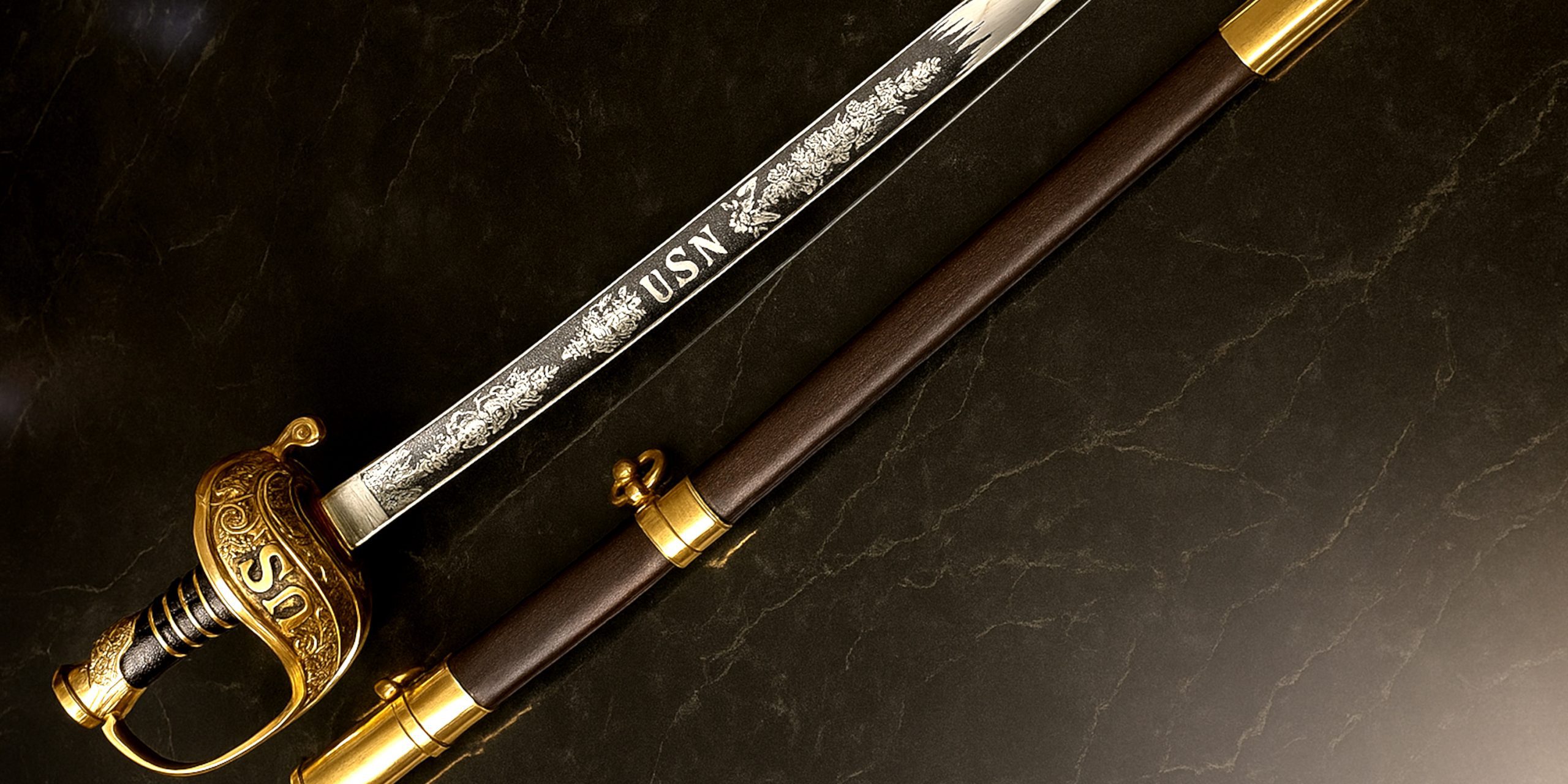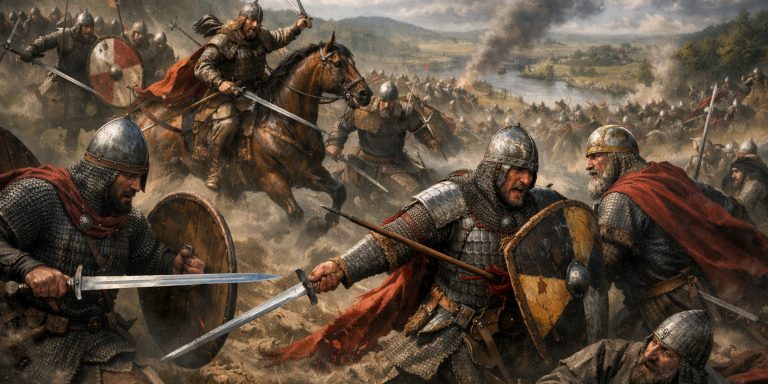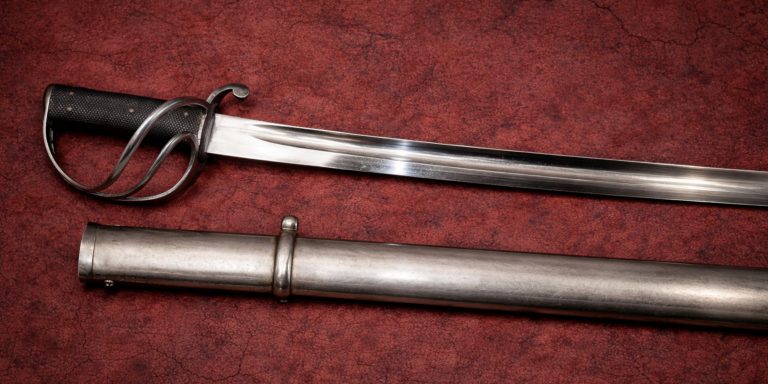
The US Model 1850 Staff and Field Officer’s Sword is one of the most recognisable blades from the American Civil War era. Carried by Union officers, it represented both authority and honour. While not designed primarily for battlefield utility, it became a symbol of leadership and pride, seen hanging from the belts of officers during parades, inspections, and the chaos of war alike.
Specifications
| Feature | Detail |
|---|---|
| Type | Officer’s Sabre |
| Origin | United States |
| Introduced | 1850 |
| Blade Length | Approximately 32–34 inches (81–86 cm) |
| Overall Length | Around 38–40 inches (96–102 cm) |
| Blade Type | Curved, single-edged with a fuller |
| Guard | Gilt brass with openwork floral motifs |
| Grip | Shagreen-covered wood (often shark or ray skin), bound with gilt wire |
| Scabbard | Gilt brass or blued steel, often with decorative mounts |
| Weight | Approximately 0.9–1.1 kg |
| Primary Use | Ceremonial and light combat |
| Users | Union Army Staff and Field Officers (Majors, Colonels, etc.) |
History and Evolution
- Origins:
The Model 1850 was based on French light cavalry sabres of the early 19th century, particularly the French Model 1845 Infantry Officer’s Sword. Its design was refined to suit American manufacturing methods and aesthetic preferences. - Adoption:
Officially adopted in 1850 by the US Army, the sword was authorised for use by field and staff officers, replacing earlier heavy sabres like the Model 1840. - Civil War Era:
It became a near-universal sidearm for Union officers. While often privately purchased, the sword adhered to a broadly standardised form. Officers prized it as much for its symbolism as for any martial use. Confederate officers, too, occasionally used captured or imported variants. - Manufacture:
Produced by American firms such as Ames Manufacturing Company of Chicopee, Massachusetts, as well as European makers like Horstmann and Clauberg. Many carried distinctive maker’s marks, etching, and regimental engravings. - Post-war Use:
The sword remained in service for ceremonial and dress purposes long after the Civil War, only gradually replaced by lighter and more decorative sabres in the late 19th century.
Advantages
- Elegant and balanced design, ideal for presentation and ceremony.
- Lightweight compared to earlier sabres, improving handling.
- High aesthetic appeal with ornate etching and gilt hilt work.
- Served as a clear mark of officer rank and distinction.
Disadvantages
- Not optimised for heavy combat due to its relatively thin blade.
- Primarily ceremonial, with limited battlefield practicality.
- Many examples were privately produced, resulting in inconsistent quality.
- Brass hilts were prone to tarnish and wear over time.
Comparison with Similar Weapons
| Sword | Origin | Primary Use | Distinguishing Features | Comparison to M1850 |
|---|---|---|---|---|
| US Model 1840 Heavy Cavalry Sabre | USA | Combat | Heavy curved blade, iron scabbard | More robust but heavier; less ornate. |
| US Model 1860 Light Cavalry Sabre | USA | Combat | Slimmer blade, brass hilt | Similar elegance but designed for field use. |
| French Model 1845 Infantry Officer’s Sword | France | Ceremonial/Combat | Etched blade, ornate hilt | Direct design inspiration; French version typically finer craftsmanship. |
| British Infantry Officer’s Sword (Pattern 1822) | UK | Ceremonial | Gothic guard, pipe-backed blade | British equivalent; more decorative and less curved. |
Legacy
The Model 1850 remains one of the quintessential symbols of Union officer authority. It appeared in countless wartime portraits and post-war commemorations, a gleaming representation of duty and command. Even today, its presence in museums and private collections evokes the refinement and ritual of 19th-century military life.
It is often cited as the last widely carried American sword that balanced ceremonial beauty with functional potential, bridging the era between the sabre and the modern officer’s dress sword.
Where to See
- Smithsonian National Museum of American History (Washington, D.C.) – Exhibits several examples with documented officer provenance.
- Gettysburg National Military Park Museum (Pennsylvania) – Displays swords recovered from battle sites.
- West Point Museum (New York) – Includes both Union and Confederate variants.
- Springfield Armory National Historic Site (Massachusetts) – Features examples by Ames Manufacturing.
Collector’s Guide
What to Look For:
- Maker’s marks (Ames, Horstmann, Clauberg).
- Etched blades with Union motifs such as eagles, flags, and “US”.
- Intact wire wrapping and shagreen grips.
- Original scabbards with minimal denting.
Condition Grading:
| Grade | Description |
|---|---|
| Mint | Virtually untouched; rare. |
| Excellent | Minor wear, clear etching, intact gilt. |
| Good | Moderate patina, some loss of finish. |
| Fair | Worn etching, grip damage, dents to scabbard. |
Typical Auction Prices (as of recent sales):
| Condition | Price Range (GBP) |
|---|---|
| Mint/Presentation Grade | £2,000–£3,500 |
| Excellent | £1,000–£1,800 |
| Good | £600–£1,000 |
| Fair | £300–£600 |
Rarity: Moderate. Commonly available, but high-quality presentation pieces or swords with officer provenance can command significant premiums.
Summary
The US Model 1850 Staff and Field Officer’s Sword epitomises mid-19th-century military craftsmanship, marrying refinement with tradition. While not a practical weapon by later standards, it captured the spirit of its time: an age when an officer’s sword was both a badge of command and a personal emblem of honour. Its enduring appeal lies not in the battles it fought, but in the hands that held it and the ideals



